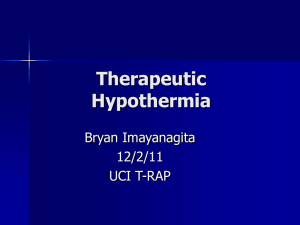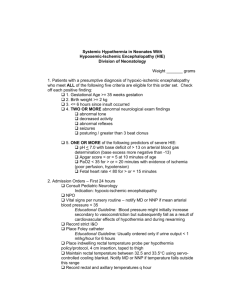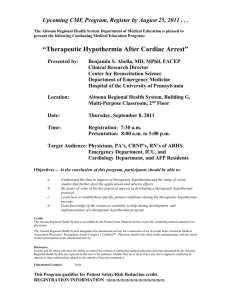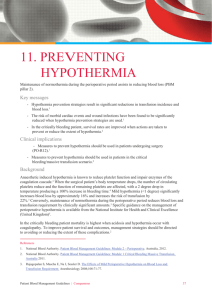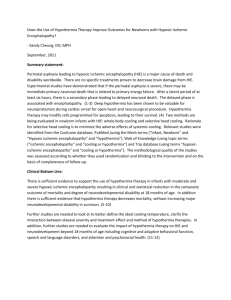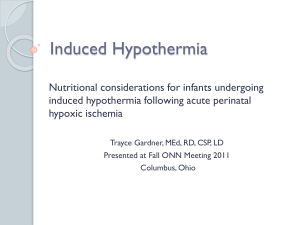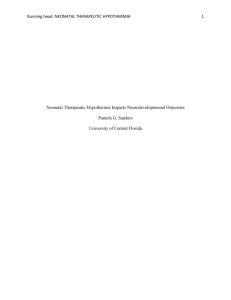Does the use of therapeutic hypothermia in newborns with hypoxic
advertisement
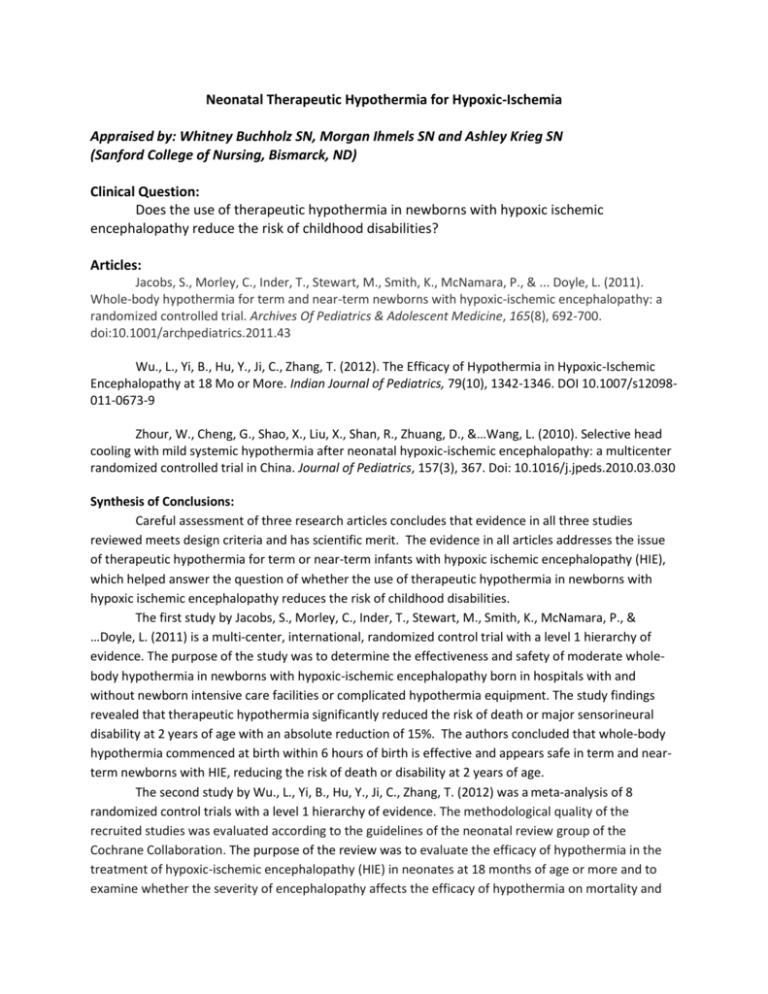
Neonatal Therapeutic Hypothermia for Hypoxic-Ischemia Appraised by: Whitney Buchholz SN, Morgan Ihmels SN and Ashley Krieg SN (Sanford College of Nursing, Bismarck, ND) Clinical Question: Does the use of therapeutic hypothermia in newborns with hypoxic ischemic encephalopathy reduce the risk of childhood disabilities? Articles: Jacobs, S., Morley, C., Inder, T., Stewart, M., Smith, K., McNamara, P., & ... Doyle, L. (2011). Whole-body hypothermia for term and near-term newborns with hypoxic-ischemic encephalopathy: a randomized controlled trial. Archives Of Pediatrics & Adolescent Medicine, 165(8), 692-700. doi:10.1001/archpediatrics.2011.43 Wu., L., Yi, B., Hu, Y., Ji, C., Zhang, T. (2012). The Efficacy of Hypothermia in Hypoxic-Ischemic Encephalopathy at 18 Mo or More. Indian Journal of Pediatrics, 79(10), 1342-1346. DOI 10.1007/s12098011-0673-9 Zhour, W., Cheng, G., Shao, X., Liu, X., Shan, R., Zhuang, D., &…Wang, L. (2010). Selective head cooling with mild systemic hypothermia after neonatal hypoxic-ischemic encephalopathy: a multicenter randomized controlled trial in China. Journal of Pediatrics, 157(3), 367. Doi: 10.1016/j.jpeds.2010.03.030 Synthesis of Conclusions: Careful assessment of three research articles concludes that evidence in all three studies reviewed meets design criteria and has scientific merit. The evidence in all articles addresses the issue of therapeutic hypothermia for term or near-term infants with hypoxic ischemic encephalopathy (HIE), which helped answer the question of whether the use of therapeutic hypothermia in newborns with hypoxic ischemic encephalopathy reduces the risk of childhood disabilities. The first study by Jacobs, S., Morley, C., Inder, T., Stewart, M., Smith, K., McNamara, P., & …Doyle, L. (2011) is a multi-center, international, randomized control trial with a level 1 hierarchy of evidence. The purpose of the study was to determine the effectiveness and safety of moderate wholebody hypothermia in newborns with hypoxic-ischemic encephalopathy born in hospitals with and without newborn intensive care facilities or complicated hypothermia equipment. The study findings revealed that therapeutic hypothermia significantly reduced the risk of death or major sensorineural disability at 2 years of age with an absolute reduction of 15%. The authors concluded that whole-body hypothermia commenced at birth within 6 hours of birth is effective and appears safe in term and nearterm newborns with HIE, reducing the risk of death or disability at 2 years of age. The second study by Wu., L., Yi, B., Hu, Y., Ji, C., Zhang, T. (2012) was a meta-analysis of 8 randomized control trials with a level 1 hierarchy of evidence. The methodological quality of the recruited studies was evaluated according to the guidelines of the neonatal review group of the Cochrane Collaboration. The purpose of the review was to evaluate the efficacy of hypothermia in the treatment of hypoxic-ischemic encephalopathy (HIE) in neonates at 18 months of age or more and to examine whether the severity of encephalopathy affects the efficacy of hypothermia on mortality and neurodevelopmental disability. The analysis showed that hypothermia reduced the combined rate of death or neurodevelopmental disability not only in moderate encephalopathy infants but also in severe encephalopathy infants. However, it is important to note that the analysis was available only from a subgroup of trials. The third study by Zhou, W., Cheng, G., Shao, X., Liu, X., Shan, R., Zhuang, D., & ... Wang, L. (2010) is a randomized control trial with a level 1 hierarchy of evidence. The purpose of the study was to investigate the efficacy and safety of selective head cooling with mild systemic hypothermia in hypoxicischemic encephalopathy (HIE) in newborn infants. One hundred ninety-four infants were available for analysis (100 and 94 infants in the selective head cooling and control group, respectively). The study findings revealed that for the selective head cooling and control groups, respectively, the combined outcome of death and severe disability was 31% and 49%, the mortality rate was 20% and 29%, and the severe disability rate was 14% and 28%. The authors concluded that selective head cooling combined with mild systemic hypothermia for 72 hours may significantly decrease the combined outcome of severe disability and death, as well as severe disability. The quality of each study was excellent, with all reaching similar conclusions. All three articles were strong and at a level 1 in the hierarchy of evidence because they address relevant randomized controlled trials and a systematic review. The two high quality randomized controlled trials were consistent in the findings that therapeutic hypothermia is beneficial in mild and severe hypoxic ischemic encephalopathy (HIE). The meta-analysis of eight high quality studies combining subgroups with a total sample size of 1,381 neonates also concluded that therapeutic hypothermia is beneficial treatment and should be implemented in the clinical setting. This sample size was sufficient and allowed for increased power. Bottom Line: There is sufficient evidence to suggest that whole-body hypothermia commenced at birth within 6 hrs of birth should be practiced because it is effective and appears safe in term and near-term newborns with HIE, reducing the risk of death or disability at 18 months to 2 yrs of age. The method of therapeutic hypothermia is uncomplicated, pragmatic, and inexpensive, and therefore it is widely applicable. Implications for Nursing Practice: Nurses working in the neonatal intensive care unit (NICU) in collaboration with Neonatal Nurse Practitioners (NNP), obstetric nurses and Neonatologists can use the evidence from these studies to support the implementation of therapeutic hypothermia in newborns that fit criteria as outlined in institutional policies and procedures. Although a number of hospitals in the region have implemented therapeutic hypothermia as a standard of care for infants suffering from HIE, many hospitals have yet to do so. Nurses working with newborns should be key players in bringing about this practice change and implementation of therapeutic hypothermia use for newborns fitting criteria in hospitals that have yet to do so.
